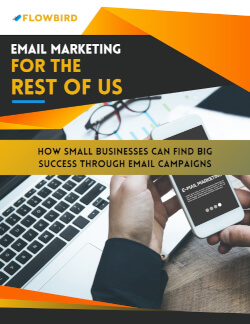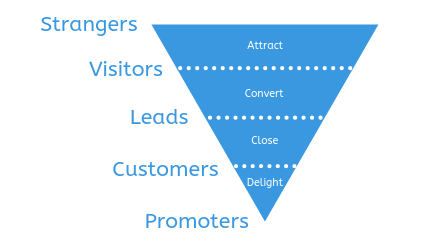Inbound marketing draws potential customers to your business using the right content at the right time and place.
Creating content for your ideal customers to consume and enjoy will naturally draw new leads to your business. They will begin to move down the sales funnel as they learn about your industry and what you do.
In this article, we’ll explore inbound marketing and its potential applications for businesses.
>> The essential components of an inbound marketing system
What is inbound marketing?
How is it different from traditional marketing?
In today’s market, prospects and customers are bombarded by marketing every day in almost everything they do. Much of this marketing goes to waste because it’s irrelevant to them.
Inbound marketing takes a different approach. Instead of throwing resources into campaigns and hoping for the best, you invest in prospects who will match your products and services well.
This method is far less intrusive than traditional marketing. It involves bringing suitable prospects to you by offering them valuable content rather than disturbing the lives of strangers who may not be interested.
Inbound marketing uses a ‘pull’ rather than ‘push’ approach, using content and a combination of SEO, social media, and other outlets. Traditional marketing, on the other hand, involves more interruptive methods, such as cold calling and billboards.
The buyer’s journey
Before jumping into an inbound marketing strategy, it’s important to understand the buyer’s journey.
Every one of your customers takes a journey between realising they have a problem and becoming a customer. This journey is likely to look different for each customer, but the broad stages are the same:
- awareness
- consideration
- decision
As mentioned above, content marketing is the key to inbound marketing. The content you create should target each of the buyer’s journey stages.
In the awareness stage, leads are looking for educational content. They are just becoming aware of their problems and begin to research them.
Leads in the consideration stage are learning about the solutions available to them. They will be seeking out expert guides, podcasts and even comparison whitepapers.
Your content should not begin to become more sales-heavy until the decision stage. These leads know what they want, and they’re deciding who to get it from. Content such as case studies, demos, and free trial downloads is just what they’re after.
With the wealth of content available for prospects to consume at their leisure, they have more control over their journey than you do. However, you can nudge them in the right direction.
>> Where do blogs fit into the buyer’s journey?
The process of inbound marketing
Inbound marketing is made up of four broad stages:
- attract
- convert
- close
- delight
Attract
The attract stage aims to make strangers aware of your business and turn them into visitors.
To attract potential customers, you need to know who they are. Buyer personas are, therefore, an essential reference point for building your inbound marketing strategy.
Using the profiles of your ideal customers, you can create the content that will form the basis of your strategy. You need to understand your prospects’ lifestyles and challenges to do this. You should also find out how and when they consume content.
You can gradually build up a wealth of content that will attract new leads and make them aware of your business.
Content such as educational blogs and videos is perfect for the attract stage of inbound marketing. You can promote your content using SEO and social media.
>> A cheat sheet for creating buyer personas
Convert
The convert stage aims to turn visitors into leads by offering them valuable content in exchange for some of their contact information.
The educational content used in the attract stage is suitable for this stage, too. Pair this content with landing pages, forms, and calls to action (CTAs).
Once leads have offered some of their contact details, you can build relationships using CRM and emails.
Close
The goal of the close stage is to turn leads into customers.
A common theme throughout all inbound marketing stages is building relationships with your contacts. In the close stage, you nurture your contacts and build fruitful relationships.
CRM and email marketing are your friends here. You should create emails and workflows that provide value to your contacts. Use personalisation and segmentation to tailor your communication specifically to leads’ individual needs.
The length of this stage varies depending on the nature of your business and its products or services. You may want to consider implementing a long-term nurture strategy for those leads who are taking longer to close.
>> What to do when a deal won’t close
Delight
The buyer’s journey doesn’t stop when a lead becomes a customer.
This stage involves turning your customers into happy promoters who share their positive experiences with friends, family and colleagues.
It sounds like free marketing, but that doesn’t mean you can put your feet up. The work required for this stage is similar to what’s required in the rest of your inbound marketing strategy. As always, good communication is key.
Before you start turning your customers into promoters, you need to provide them with excellent service and make them feel welcomed and valued as customers.
Consider implementing a welcome series. You could include emails about FAQs and tutorials for using your products and services or check in to see how they’re doing.
You could also recommend other products or services that may benefit them. This will make your customers feel understood, and you’ll also benefit from any resulting cross-sells.
Don’t make the mistake of dropping off the map as soon as a customer has made a purchase. Keep in contact and make it easy for them to get in touch with you if they need to.
Following this, you can capitalise on your happy customers by encouraging them to spread the word. Online reviews and surveys work well for this.
We’ve covered the basics to answer the question, ‘What is inbound marketing?’
A lot goes into creating a successful strategy, and it can seem daunting to do it from scratch. At Flowbird, we’ve seen the benefits inbound marketing can bring to a business. Get in touch to see what it can do for you.
